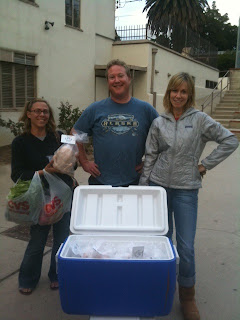
Savory tarts are wonderful. You can make them in a wide range of sizes from bite-sized mini-tarts that make nice appetizers to large tarts that you cut in slices to serve. You can make them in any shape you like, and the topping combinations are endless.
The toppings I used for today's recipe include carmelized onions and potatoes. These ingredients require a little advance preparation, but once you have them (and your crust), it takes only a few minutes to assemble and bake the tarts.
Carmelized onions are super delicious and very versatile. In addition to these tarts, carmelized onions add great depth of flavor to many dishes. It takes an hour or so to properly carmelized onions, but you can do this step ahead. Cook up a big batch of carmelized onions and store them in your fridge. They'll keep for about a week. Mix them into mashed potatoes; add them to grilled cheese sandwiches; toss them into an omelet. You'll find myriad uses for them.
To carmelize onions: Peel and slice 2-5 onions thinly lengthwise. Melt 1-2 t butter per onion in a large, heavy skillet over low heat. Add the sliced onions and cook over low heat, stirring regularly, until the onions turn a deep brown color. Season with salt and pepper, if desired.
The potatoes I used in this tart were boiled ahead of time, chilled and sliced. It's easier to thinly slice a cold potato. You can cook up the potatoes when you're making this recipe, just allow them to cool before slicing them.
These tarts start with the same pie crust recipe I used last week. But you can use your favorite short pastry crust. I rolled out my crust to approximately 1/4" thickness and cut it with a round, fluted-edge form that's five inches in diameter. This size makes a great individual tart.
I like making flat tarts that I bake on cookie sheets, but you can make this recipe in a tart pan if you prefer. The flat tarts are a little easier, but be sure to let them cool before lifting them off the cookie sheet, as the pastry dough is delicate when it just comes out of the oven.
To make crust for six, five-inch diameter, round individual tarts: Take 7 T cold butter, cut into pieces, plus 1/2 T salt, and 1-1/3 C flour. Put all the ingredients in a large bowl. Using a pastry blender or a fork, cut the butter into the flour under it resembles coarse crumbs. Mix in a little ice water and continue to mix until the dough just comes together. Form into a flat disk and refrigerate for 10-30 minutes. You can refrigerate this dough longer, but it might be harder to roll if it's colder.
For six individual tarts:
Crust recipe above (or your favorite crust)
1-2 medium Russian Banana or Fingerling potatoes, boiled and cooled
1 C Carmelized onions, or more to taste
1/2 C crumbled goat cheese
1/2 C washed, dried, and finely sliced fresh arugula
1. Pre-heat oven to 400 degree F.
2. Roll out pastry dough 1/4" thick and cut six circles, each five inches in diameter.
3. Divide and spread the carmelized onions over each piece of dough.
4. Slice the potatoes thinly and arrange 2-3 slices over the onions on each tart.
5. Sprinkle a little crumbled goat cheese over each tart.
6. Bake in pre-heated, 400 degree oven for 10 minutes, or until the edges of the crust are golden.
7. Cool on cookie sheet for 5-10 minutes before lifting off with a metal spatula. Garnish with finely sliced arugula before serving.
Variations: Grated gruyere cheese is a nice alternative to goat cheese. Omnivores may like to add a little cooked and crumbled chorizo to these tarts.
Today's bounty included:
From Underwod Family Farms: Butter lettuce, rainbow chard, sugar snap peas, carrots, candy beets, mizuna, celery, and navel oranges.
From Weiser family Farms: Parsnips, mixed beets, and Russian Banana potatoes.
From Sage Mountain Farm: Salad mix, white and orange carrots, arugula, spaghetti squash, turnips, and Russian kale.
Urban farmer, Russell Wightman, provided the Fuerte avocados from Highland Park.
Happy New Year everyone!
Shelley




























